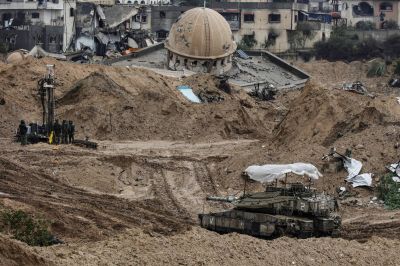A picture taken from a position in southern Israel along the border with the Gaza Strip on Jan. 19, 2024, shows an Israeli tank rolling along the fence with damaged buildings seen in the Gaza Strip. (Credit: Jack Guez/AFP)
During a revealing press conference held Wednesday evening in Tel Aviv, Israeli Prime Minister Benjamin Netanyahu declared that Israel had rejected Hamas' cease-fire and hostage exchange proposal, that the Israeli army would advance into Rafah, a district packed with displaced Palestinians, and that "total victory" in Gaza was within reach, despite the fighting that rages on throughout the enclave.
The deal Israel rejected had been Hamas' counterproposal to a framework drawn up during the Paris meeting between Israeli, Egyptian, Qatari and American heads of intelligence and presented to the Palestinian movement shortly after.
Israel has been firm on its refusal to completely withdraw forces from Gaza until Hamas is dismantled. Hamas, on the other hand, refuses to agree to any hostage-exchange deal that doesn't include a comprehensive cease-fire and the removal of Israeli military presence.
Israeli officials believe there are 136 hostages remaining in Gaza. On Tuesday, the New York Times reported on an Israeli investigation that concluded 32 hostages were presumed dead, most of whom the army suspects were killed on Oct. 7.
So what was it exactly that Israel rejected? Reuters was able to view a text of the proposal. In short, they say it aimed to end military operations with a sustained de-escalation, exchange hostages and prisoners, end an Israeli blockade of Gaza, allow displaced residents to return home and ramp up aid supplies.
Here is their outline of what the proposal included:
First 45 days:
Temporary halt to military operations, end of aerial reconnaissance, repositioning of Israeli forces far outside populated areas in the entire Gaza Strip.
Release of Israeli civilian women and children aged 19 or under held hostage in Gaza, as well as all elderly and sick hostages.
Release of Palestinian women, children, elderly and sick from Israeli jails.
Agreement on release of 1,500 Palestinian prisoners, with Hamas to nominate 500 of them who have been sentenced to long or life sentences.
Increase in humanitarian aid into Gaza, including the north, and return of displaced people to their home districts. Start rebuilding hospitals, homes and other facilities. UN agencies to provide services and establish shelter camps for population.
The next 45 days
Discussions to be completed before start of second phase on conditions to maintain cease-fire.
Release of all Israeli male civilian and military hostages in exchange for other Palestinian prisoners.
Continuation of humanitarian measures in Gaza.
Israeli forces to withdraw outside Gaza Strip.
Comprehensive reconstruction to begin and blockade of Gaza to end.
The third phase of 45 days
Exchange of bodies and remains from both sides after their identification.
Continuation of humanitarian measures in Gaza that were agreed upon in earlier phases.
